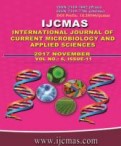


 National Academy of Agricultural Sciences (NAAS)
National Academy of Agricultural Sciences (NAAS)

|
PRINT ISSN : 2319-7692
Online ISSN : 2319-7706 Issues : 12 per year Publisher : Excellent Publishers Email : editorijcmas@gmail.com / submit@ijcmas.com Editor-in-chief: Dr.M.Prakash Index Copernicus ICV 2018: 95.39 NAAS RATING 2020: 5.38 |
Experiment was conducted in factorial randomized blocked design with three replications comprised of eight treatments of four levels of potassium i.e. 50, 100, 150 and 200 kg ha-1 and two levels of vermicompost i.e. 0 and 20 tha-1. Significantly maximum dry matter content, specific gravity, TSS%, physiological weight loss % and rotted % was noted in treatments K4 (200 kgK2O/ha) followed by K3 (150 kgK2O/ha) and lowest dry matter content, specific gravity, TSS%, physiological weight loss % and rotted % was recorded in treatment K1 (50 kgK2O/ha). TreatmentVC1 (20 t VC ha-1) was recorded significantly maximum in all quality and storage parameters, while, it was recorded lowest in treatment VC0 (0 t VC ha-1). Higher dry matter content (%) was achieved which might be due to application of vermicompost that played a positive role in affecting dry matter of tubers. Among interaction effects, significantly maximum dry matter content, specific gravity, physiological % and rotting % was recorded in treatments K4VC1 (200 kgK2O/ha+ 20 t VC/ha) followed by K3VC1 (150 kgK2O/ha+ 20 t VC/ha) andK2VC1 (100 kgK2O/ha+ 20 t VC/ha). While, the minimum was recorded in the treatment K1VC0 (50 kg K2O/ha + 0 t VC/ha). Higher dry matter content (%) was achieved which might be due to application of vermicompost and potassium that played a positive role in affecting dry matter of tubers.
 |
 |
 |
 |
 |